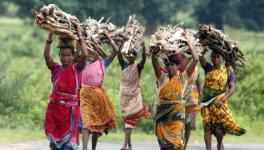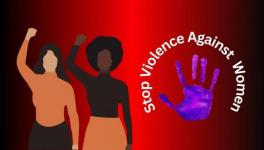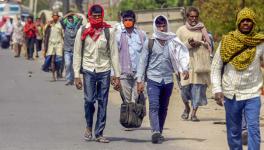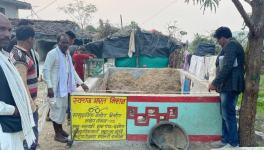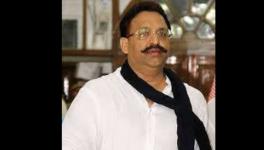18-Year-Old Girls With Stakes in Azaadi Will Save Indian Democracy

The NewsMinute
Surinder S. Jodhka, a professor of sociology at Jawaharlal Nehru University, has written extensively on caste, social stratification and rural and agrarian change. In an interview with Pragya Singh, he discusses the evolution of India’s villages since the early years of India’s independence and becoming a republic, which is also the subject of a recent book edited by him and Edward Simpson, India’s Villages in the 21st Century: Revisits and Revisions. Jodhka discusses the deep roots of Indian democracy and why movements like Shaheen Bagh represent an irreversible social change. “I have been saying for the last four years that the only person who can save Indian democracy is the 18-year-old girl, who has the highest stakes in being free—Azaadi,” Jodhka says, adding, “She has struggled to get here, she is also privileged and realises that these are privileges and that they can be taken away.”
Your latest book reinforces the abiding importance of land in rural life. But typically, it records that land remains in the hands of the same communities and groups as earlier. If so, then what has changed in rural India in recent decades?
People who own land are also, in some sense, the hegemonic class. I am using the word class even though they were also a caste, a dominant caste. Within that caste, two or three families would hold large volumes of land in a village and everyone would depend on them, because that was the source of their employment. They were also their mai-baap, in the sense that if you needed some money for getting your child married, they would help you. There was a patron-client relationship which went along with land ownership.
So first, that has changed, for two reasons. One, there has been a casualisation of the labour relationship. Earlier, there was a bondage or attachment between the landed and the landless, and the latter were invariably Dalits and lower OBCs, who were completely landless. Today, this phenomenon, what was called jajmani in customary terms, has vanished from almost everywhere.
There are still remnants of it; for example nobody will do the scavenging job other than the scavenging caste people and, as you said, land is still with the same communities and castes, but the second related change all over the country is that the average size of land holdings has come down quite significantly. In parts of Bengal, Bihar, east Uttar Pradesh and Rajasthan, landlordism was to some extent dented by land reforms, but things changed majorly after the Green Revolution in Punjab, Haryana and western Uttar Pradesh. For example, labour used to migrate from rural Bihar to Punjab, but once Bihar changed because alternative sources of employment became available outside, a politician such as [three-time chief minister] Lalu [Prasad Yadav] could emerge.
So the size of largest holding is smaller and the number of people who have large holdings is also much smaller than before. What is the effect of this?
Some rich farmers of the Green Revolution diversified into urban occupations and, through politics, went into the cities to work in real estate, etc. The ‘provincial propertied classes’ moved to the cities, their children became doctors, lawyers and so on in cities. That kind of mobility also takes away from the village its spokespersons. For example in the 1980s, there was a very powerful farmers’ movement in many parts of India. In Punjab, I saw the leaders of the Bharatiya Kisan Union, which led this movement, become adatias [wholesale traders] in urban mandis. They diversified to join the people they were fighting. They dissociated from the village, so there is nobody left to speak for it. This is the time when suicides start in rural India massively, but farmer-politics declines.
And the proportion of people who depend on agriculture declined in the last seven decades.
Yes, the proportion of rural population has declined from 85% to 67%, but the absolute size of the rural population is five times more than what it was. And the more people are dependent on agriculture, the smaller holdings become, unless you are able to diversify. Some people have diversified entrepreneurially, but the current diversification, in most cases, is a subsistence strategy.
For example, the security guard standing outside this building would be say, a Bhumihar from a village in Bihar, or Chhattisgarh or Jharkhand, who would own half an acre of land which is being cultivated by their fathers and wives living in the village. This is a new kind of rural-urban arrangement. That’s our argument in this book, that the trajectories of change vary even though patterns are significant everywhere.
What do you mean by trajectory and pattern?
See, this security guard in Delhi never becomes ‘urban’. He is a circular migrant. He would spend his working life here, but that half-acre of land in the village is critical for his survival.
Yet in today’s village, you are far more linked to the urban than ever before.
Precisely, there are different trajectories for different kinds of people. In Bihar, there has been no investment in agriculture even though the quality of its land is very good, but in Punjab after Green Revolution nobody is desperately poor or starving in villages. They come to urban places and become taxi drivers, but not work on construction sites to provide subsistence to their family. The Jat farmer can sell his one acre of land for Rs 30 or 40 lakh and transfer a son to another country to diversify his income in Punjab. Whereas for the Bihari labourer, diversification is a compulsion for survival, because with half-acre you can’t reproduce yourself biologically. So they go to cities and work as whatever they can to escape starvation...
Rajni Kothari had said that caste changes its role, not itself. Is caste as powerful as 60 or 70 years ago?
I personally feel that this is an argument of the dominant caste, because in this view caste has become a horizontal reality and can be seen as ‘Indian civil society’, and therefore democracy and caste are seen as compatible. The problem with that view is that inequalities persist. Even though dominant [rural] castes are on the margins compared to urban professional classes, it is still their mobilisation along caste that helped them participate in the political process as equals. Today Dalits are [also] able to come to cities and contest elections etc, but inequalities of caste persist because Dalits remain landless. As we know, even half an acre or two acres of land in Haryana, Punjab or Maharashtra make a lot of difference to your life chances.
So upper castes of rural Bihar become IAS officers or businessman and go all over the world while OBCs become vegetable vendors and lower OBCs would become security guards, but Dalits would be construction workers. This has been empirically recorded by us and others and it is why the notion of peasant society doesn’t work in India.
So because of caste there is very often no wider consolidation as peasant.
That is why Rajni Kothari is not sufficiently right. I’m not saying he is completely wrong. There is some horizontal consolidation—this term was popularised by MN Srinivas—but there is no equality of caste. For example, urban upper castes use caste as a resource for their own mobility and stability at higher positions.
You mean that whether they want to or not, they have a caste advantage.
No, they actively use it, not only in family business. Corporate hiring, too, happens through networks. Why are Jat, Patidar or Maratha boys protesting? They are educated, the quality of their education is poor, but more importantly, they don’t have networks. Therefore, their consolidation is different from upper caste consolidation, which works around the idea of merit and castelessness. The upper castes pretend to be against caste while they are actually preserving their own private space very carefully and intelligently by using the language of merit. For Dalits, it is even worse. They remain landless and there is no employment available in the village, but the only space they have in the urban economy is at the lowest end of the informal sector.
The essays consolidated in your book show that in villages near industries Dalits have been able to work in a city and live in the village. Can mass employment change the caste matrix?
Earlier, the government generated jobs. The Indian Railways, for example, created jobs and that is how mobilities started. Our studies show that the elites [in Indian society] are those who have the highest proportion of members of their household working outside [the village] in privileged jobs. But after the nineties, the employment available outside was not direct recruitment by factory owners or government. Most of it is outsourced through hiring agencies, who further outsource the hiring to contractors. That is where kinship networks become very critical. When there is limited employment available, the chances are that it is the OBCs who will get that job rather than the Dalits, because they are the ones likely to have networks and contacts with urban hirers. That’s where caste begins to reproduce itself much more after the nineties.
The intermediary hirers work on kinship and other kinds of networks and that is how inequalities around identities are reproduced. Privileged jobs will become available [to non-elite castes] only when either there is much higher demand than supply or when there is open recruitment.
How do we understand the agitations of the landed communities in this context? We see inter-caste conflict, but what is the role of intra-caste inequality in fuelling a sense of thwarted aspiration?
There are some tentative answers from empirical studies, which show that when people move up within certain [dominant] castes, they also tend to invest in the consolidation of their caste-communities. For example, the Kamma diaspora [from Andhra Pradesh] is very heavily invested in philanthropic activities for their own community. The same is true of the Agarwals—in order to consolidate their mobility, they started looking at themselves through the prism of ‘Agarwal-ness’. This produces a new kind of Agarwalness. For instance, they create Agrasen as their own god, start journals, and to protect urban privileges they invested in caste associations, which resolve the question of whom to marry. Then their numbers begin to matter through democratic politics.
Everyone is developing their own communities based on kinship and proliferation of caste-based politics of a certain kind is helping the BJP because they are able to intelligently go into these jaati-level associations rather than the old consolidations of OBCs and upper castes etc, whose moment is gone.
So even if inequality is greater within a dominant community, they will tend to consolidate rather than fracture?
This is very important. In neo-liberal capitalism, those who are or were privileged and those who are less privileged, are looking for resources that they can command. You need some contacts, some networks, to do this. In India, we don’t have a kind of generic notion of trust... Even in America,, corporates will recruit through the local church, because you need some sense of a person’s allegiances which are not just market-based.
Caste has become a more valuable resource post the 90s than earlier because democratic politics has also become a very important resource, given that mass employment is unavailable. Therefore, whether in urban settlements or when you return to the village, you remain within your kinship group.
On Republic Day we hear about the Constitution, but are people actually aware of their rights? If they do not want to be tied to a landlord or if untouchability has receded, that means people are aware of rights, but to what extent?
The rural-urban binary itself is part of the urban middle class’s hegemonic strategy, wherein we claim that we know what is good for them. They know everything and they know it better because it relates to their own condition. Obviously, the rural power structure has changed from the earlier caste-based politics to a new kind of class-based politics, where state schemes have become very critical resource for a rural household’s survival. Those state schemes then bring in the role of fixers or ‘political entrepreneurs’ or ‘netas’ who then become very useful connectors...
There is a discussion on why some sections of the Opposition are not very stridently speaking against the government's proposal for NRIC. One explanation is that NRIC will become a service that local leaders will provide to people...
[Laughs] Yes, this is how, in some sense, the political entrepreneurs reinforce their indispensability. That is how power is going from the town to the country. The same people have migrated to the city from where they now control rural politics through clientele-based networks. Yes, there are gender differences, class differences, but democracy has gone very far and wide.
And we cannot easily take away the sense that we are equal at least in terms of the vote.
In 1987 or 1988, a man told me how being an attached labourer is like being “the wife of the employer whose body he has complete control over”. The sentence was repeated verbatim, twenty years later, by another person in the same village, where there were still few attached villagers. So freedom has its own value; even if they get ten rupees less [working in a city], they value it more.
Not only democracy, people in villages also know hard economics, while we talk about rural people as simple and incapable of thinking rationally. For example they understand, without knowing about it, Marx’s theory about surplus labour: “Dekho, yahan mai 12 ghantey kaam karta hoon. Bahar mai che ghantey me itney kama lunga. Che ghantey kahan gaye? Yeh to le gaye na...” [I work in the village for 12 hours. I would earn the same amount in the city for six hours of work. So the landlord has taken away six hours of my effort]. So what people tell me in villages is what we teach in the classroom, Marx’s labour theory of value, the theory of exploitation...
We need to also see things as they are. Why has BJP become so popular in Haryana? Because local relations of dependencies have changed. People are floating around. They are going to deras, they are they looking for some sense of togetherness.
Is India more overtly religious now than it was 20-30 and 50 years ago?
Rural areas, yes—people are much more demonstratively religious than they were. What we call mobile religiosity has also increased. Earlier, religion was practised at home, now you have kanwariyas and people visiting deras. You also have the idea of being Hindu, which would also mean being ‘global’ at some level. Religion is also a resource through which you build associations with others that gives a sense of community, belonging and security which they don’t have in villages any longer.
And the government promotes teerath yatras...
Government knew there is a demand, so it facilitates this and in the process a new kind of clientele-politics service-provision takes place; where you offer to help Ravidasis of Punjab who want to go to Banaras every year...
To the Ravidasi temple constructed in Banaras and which has been refurbished with a lot of gold...
Yes, the Ravidasi temple of Banaras has been constructed by Punjabi Dalits from Jalandhar... [laughs].
If communities are indulging in religion, is it a failure of the state?
At some level, yes. You [always want to] consolidate the resources you have. People see religious activity as a “resource”. Also, this is the only way they can begin to think of being human and equal. Partly, this is because of the process of internal differentiation. Consider a rural family whose one son has become an officer. Now he does not want to visit his home. So with mobility you tend to psychologically distance from your own community.
How does this change politics? It is simply a patron-client relationship of sorts, jajmani of a new kind?
They [people] become available for variety of mobilisations; Hindutva being one kind, which can then transcend caste, patron-client structures, even gender...
We talked about caste, but how have community relations in rural India changed?
When communities migrate, it is generally into urban areas. Therefore, ethnic diversity is an urban reality much more than it is a rural reality, But rural is not different from urban, so when identity politics becomes a norm, it spreads. When identity or community conflicts start, they also tend to spread.
In the 1980s I met some Gujjars in a village near Panipat in Haryana. They were Gujjar Muslims, who had said that they would stay on in the village [during Partition]. ‘Hum toh Hindu ban jayenge—we will become Hindu,’ they had argued. Even the Hindu Gujjars of this village had no religiosity, so the Gujjar Muslims had stayed on despite communalisation.
This village had no mosque and as far as my first fieldwork in the 1980s was concerned, there were no Muslims in it.
When I returned to the same village in 2008, there were many Muslims and a mosque or two. Who were these Muslims? The same Gujjar families that had stayed back. What happened is that when they had married their children, they had preferred to go “Yamuna paar,” where there were other Gujjar Muslims.
In the Uttar Pradesh side of the Yamuna?
Yes. They intermarried with Muslim Gujjars from Uttar Pradesh, who brought with them Muslimness from across the river and helped them build a mosque in their village. Once it came up, suddenly we heard [in 2008] that the Jogis of the village are also Muslims, not Hindus. [Laughs]. Until then, they were [just] Jogis, nobody knew their religion, but when they were asked to choose, they said their gods are closer to Islam than Hinduism and thereafter started being enumerated as Muslims. These divisions begin to emerge recently, in the last decade or two. So, yes, rural areas are also more divided on religious lines today, along with caste lines.
Okay. So, where does this where does this bring India, 70 years after becoming a republic?
I think we made the better choice after Independence to have a developmental state. If we had made made the choice Pakistan made, we would have been much worse off. Development would not have been possible without the state and the state would not have been accountable without democracy, and democracy, or electoral politics, or clientele politics, also changes the state in a manner that it cannot be completely divorced from the realities on ground.
Things are changing today, they are perhaps looking bleak. We don’t know what will happen tomorrow, but I think people are really seeing themselves through the prism of development. The source of their self-realisation is, I think, questions of livelihood, notions of a better life—and better right here...
Now politics is raising questions on people's citizenship, but rural India isn’t as agitated as are townspeople, city folks, but the complex process of enumeration in the NRIC can in itself become a punishment in rural India.
I know what you’re saying, but cannot claim to know why rural India has not really been mobilised [over NRIC]. The thing is, Indian society really needs to complement the lower-middle-class father who has enthusiastically allowed his daughter to study... Even though the family wanted a son or has a son, they educated their daughter. Mobilising all resources, working overtime, they sent her to JNU, Jamia and IIT. These young girls in their early 20s are far smarter and articulate than I was at 40! Something in India has changed, which you can’t reverse.
You can with a lot of violence, you’ve seen police attacks on them...
But that would be something else, right? It will not be [society] reversing [itself]. You can have Fascism, but again this is not the 1950s. Yes, things are changing negatively also, but that is different from ‘going back’. These women are not going back. As I have been saying for the last four years, the only person who can save Indian democracy is 18-year-old girls, who have the highest stakes in being free—Azaadi. They have struggled to get here, they are also privileged and they realise that these are privileges and that they can be taken away. [As do their families.]
There is an attack on education today, no doubt, but the aspiration for education is not declining, it is expanding every day. Today, everybody says that the Constitution must be saved. This is a very positive development, which reflects democracy. Even though [the current politics] is countering some of the advances, it [the present moment] is also an expansion of gains; wherein people are realising what is at stake.
Is Shaheen Bagh a very urban phenomenon?
Yes, it would be. For the first time in India’s history what Ambedkar used to talk about—fraternity—is being mobilised at Shaheen Bagh. People are thinking that it is important to be nice to the other person for the first time. This is an urban phenomenon, but the kids over there are not urban middle classes...
What are they, then?
That’s what I am saying: there is no rural-urban distinction. Many of them would have migrated from rural Bihar to Delhi and have been living here for the last 10 years, five years or few months. If Shaheen Bagh was happening in a small town in Madhya Pradesh, we wouldn’t even know about it. So many protests happen everywhere in India, they don’t get visibility. Shaheen Bagh is Shaheen Bagh because it is happening in Delhi.
Get the latest reports & analysis with people's perspective on Protests, movements & deep analytical videos, discussions of the current affairs in your Telegram app. Subscribe to NewsClick's Telegram channel & get Real-Time updates on stories, as they get published on our website.










